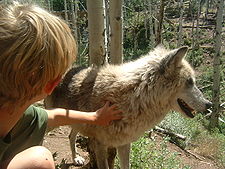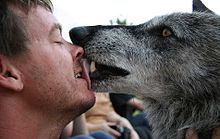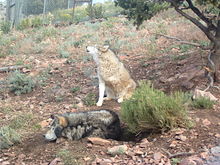- Mission: Wolf
-
Mission: Wolf (Abbreviated M:W) is a remote wolf sanctuary near Westcliffe, Colorado. Housing up to 40 wolves and wolfdog crosses, Mission: Wolf works to promote a better understanding of wolves in order to further reintroduction efforts and discourage attempts to keep wolves as pets. People are welcome to visit and not only see the wolves up close, but have an opportunity to touch them as well. There is a nearby meadow where visitors can camp overnight. The 15 miles of dirt road that climbs to 9,000 feet is driveable in the summer (if not wet) by normal 2WD vehicles.
Contents
Founding
Mission: Wolf was founded by Kent Weber and his wife, Tracy, as a remote shelter for a dozen wolves and wolf-dogs. In the first year of constructing a house, they took in several wolf puppies. As word got out, visitors came and started to help the Webers build and work, and called themselves volunteers. With more people working, more fencing could be constructed and more wolves could be adopted.[1] In the peak of Mission: Wolf's adoption frenzy, they had 52 wolves and wolf-dogs, before they realized that they could not possibly accept every wolf.
Mission statement
Weber's mission goal is that there will be no more captive wolves. This is unlikely to happen in the foreseeable future. In addition, Weber aims to educate the public in general about the behavior of wolves, and to clear their reputation as 'The Big Bad Wolf.' He also is active in trying to dissuade people from breeding wolf-dogs and owning either wolves or wolf-dogs as pets.
Meeting the wolves
Often, several visitors come up to Mission: Wolf daily for a tour. If they come at the right time, Kent may take them into one or more enclosures to meet the wolves personally. This, he says, is one of the most vital parts of his education goal, and this is summed up by a quote from a recent visitor to M:W:
What we hear, we forget. What we see, we remember. What we touch, we understand. —A Fourth Grade Student
Mission: Wolf also tours the country as a part of its Ambassador Wolf Program, traveling thousands of miles in their Wolfhound, a full-size Greyhound Bus that was converted to be able to house, minimally, two adults and two wolves, and assorted supplies.[2]
The Ambassador Program visits:[3]
- Government agencies-USFWS, NPS, NFS, BLM, USDA
- Conservation groups-Sierra, Audubon, Nat'l Wildlife Fed
- Universities-Harvard, Cornell, CU, ASU, UNM, UVM
- Schools-Private, Public, Disabled, Colleges, Preschools
- Clubs-Boy's & Girl's, 4-H, Scouts of America, Zoo's
- Museums, Nature Centers, Libraries, Law Firms, Corporations
- TV Specials that have included National Geographic, ABC, CBS, NBC, CNN, PBS, Mr. Rogers to the NBC Today Show, TV and Radio talk shows.
An example of topics discussed during the Wolf Programs include:
- Introduction to the world of Wolves and Hybrids
- Wild wolf issues; Rocky Mountains, Eastern, Mexican
- The Trophic Cascade; Lessons from Yellowstone National Park
- Captive wolf status, wolf hybrid ownership experiences
- Wolf communication and behavioral comparison to dogs
- Current status of wild wolves in North America
Greeting behaviors
Wolves use their mouths and noses to communicate and greet. When a group of people go into one of the enclosures, they sit down with their backs to the fence on a wooden log bench. Throughout the years, Kent and his staff have perfected the way to greet the wolves, and to teach them how to greet people. Most wolves greet one another by making eye contact, biting each other on the cheek and sniffing one another's nose and teeth. Over time, Kent has been able to teach some wolves, those who are more outgoing with humans, to only lick and sniff teeth while making eye contact with humans. In this way, it has become completely safe for people to go in with wolves such as Maggie, Raven, Merlin, Orion and Soleil.
Because human instinct makes us want to close our eyes and back away from the wolf when they come up close, Kent gives very strict instructions to make eye contact and bare teeth at the wolf. When people do look away or back off, the wolf will follow. They really want to look into the person's eye, and if the person continues to refuse, it is the equivalent of an insult, telling the wolf that they don't like them. Kent likens it to a child coming up to their mother for a hug, and the mother slapping the child away.
Volunteers
Many people make the journey to volunteer at Mission: Wolf each summer, and several stay two months or more to serve as staff. Staff usually receive a small stipend, and are provided meals and housing. They also have access to all electronics.
Housing
Housing includes:
- 5 Canvas Tipis
- 2 Community buildings with lofts available to anyone
- 2 Staff lofts, one above the office and the other above the old kitchen.
- 2 Rooms above the veterinary building, affectionately called "The Puppy Palace."
Resources
All the buildings at Mission: Wolf were built by volunteers and with donated materials. M:W is almost completely self-sufficient, using donations to pay for what they need, solar power on sunny days, and a propane generator when it is needed. Most ranchers in the area donate their livestock to the wolves when they die, giving the wolves a steady supply of feed. Satellite provides wireless internet available to anyone at the refuge.
Wolves
Mission: Wolf takes in only wolves who were born in captivity. Wolves that are born in captivity can never be returned to the wild, and thus, they live out their lives at Mission: Wolf. They prefer to take in only puppies, as full-grown wolves are very difficult work with if they haven't imprinted on the staff. As of July 15, 2008, 20 wolves and 5 wolf-dogs live at Mission: Wolf, with 2 more high dog content crosses being kept at Kent and Tracy's farm. Since founding, M:W has had to turn down over 9000 requests to take in wolves and wolf-dogs.
Feeding
The wolves are all fed once a day, in what is called daily feed. This practice only began in summer 2008, and is mainly used as a vessel to provide vitamin supplements and medications to the wolves; before that, the wolves had only received the feast-and-famine cycle of two large meals a week, similar to their eating schedule in the wild. This is now called "big feed", and still occurs twice a week, though the wolves get slightly less food, as some is stored away for daily feed. Most often the donated livestock is horse meat, although turkeys, cattle, and roadkill deer are not unheard of.
References
- ^ Mission: Wolf's Official Website: http://www.missionwolf.com/
- ^ Wolfhound
- ^ The Ambassador Wolf Program
External links
Categories:- Geography of Colorado
- Wolves
Wikimedia Foundation. 2010.




